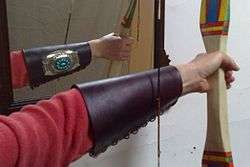Bracer
A bracer (or arm-guard) is a strap or sheath, commonly made of leather, stone, or plastic that covers the inside of an archer's arm to protect it while shooting. Bracers protect the inside of the archer's forearm against injury by the string of the bow or the fletching of the arrow. They also prevent loose clothing from catching the bow string. They normally cover part of the forearm only, but chest-guards are sometimes worn, usually by female archers, and other areas have at times been protected. With some combinations of non-baggy clothing and bows with a larger distance between the bow and the string, the archer may not need to wear any bracer.[1]
_MET_DT11932.jpg)
Decorated bracers
The modern Navajo people and Hopi developed a form of bracer known as a ketoh, which can be decorated with silver, turquoise, and other adornments, possibly from earlier examples made of bone.[2] Ketohs usually have a central motif, sometimes with a stone ornament, and four curvilinear shapes that radiate toward the corners. Ketohs may have a smooth leather surface on the inside of the arm and are then functional, but they are normally used as items of personal and ritual adornment, or as works of art in their own right.[3]

Stone wrist-guards from Beaker culture graves of the European Bronze Age have been thought to be archery bracers. However, they are usually found on the outside of the arm where they would have been more conspicuous. Many have only two holes which would make them difficult to fasten securely to the arm, and some have projecting rivets which would catch on the bow string and make them unsuitable for use as a bracer. Many show great skill in polishing and stone working, and few are found in areas from which their stone originates. When the objects occur in barrows, they always occur in the central primary grave, a place thought to be reserved for heads of family and other important people. They may have been status symbols of prowess in hunting or war, probably mounted as decorations on functional bracers. A few wrist-guards made of gold or amber have also been found; scholars believe these were for ornamental rather than functional use.[2] A review identifies two major sources of stone from which they are made, suggests that they may well not be connected with archery, and highlights other potential uses.[4]
Other uses
Bracers have also been used in other sports, including ball games such as Follis (played in ancient Rome).
In many common role-playing games, bracers are a general piece of armour rather than protective archery equipment, possibly due to confusion with vambraces.
Notes
- Toxophilus - the School of Shooting. by Roger Ascham. Read Books 2006. ISBN 1-84664-369-4 ISBN 978-1846643699
- Harry Fokkens, Yvonne Achterkanp, and Maikel Kuijpers, "Bracers or Bracelets? About the Functionality and Meaning of Bell Beaker Wrist-guards", Proceedings of the Prehistoric Society 2008, vol. 74, pp. 109-149
- "KETOH. Navajo. Silver and Leather" Archived 8 September 2008 at the Wayback Machine, Millicent Rogers Museum of Northern New Mexico Collection, Accessed 25 February 2008
- Hunter and Woodward et al "An Examination of Prehistoric Stone Bracers from Britain" An Examination of Prehistoric Stone Bracers from Britain
External links
- Archer's Gear: The bracer, La Belle Compagnie Website
- Roundway G8 burial Wiltshire Heritage Museum, Devizes
- Ketohs, collection of the National Museum of the American Indian
